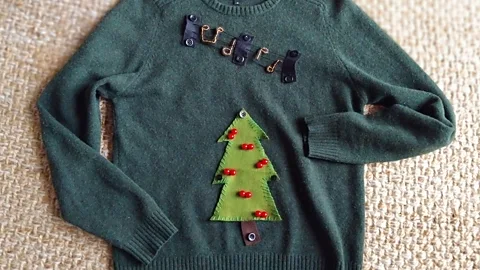I created a Christmas jumper I can wear every season
 Matilda Welin
Matilda WelinMatilda Welin sets herself the task of creating an affordable, environmental and long-lasting Christmas jumper, choosing recycled materials over fast fashion.
Christmas jumpers are fun. But they are also ugly, bulky and unpractical. Who thought synthetic knitwear was the best option when mingling in a sweaty crowd next to live candles? They're unsustainable, too, with up to 95% containing cheap plastic materials.
One in 10 people threw last year's Christmas jumper in the bin and almost two-thirds of 25-34-year-olds own more than one, according to research by Hubbub, an environmental non-profit in the UK, carried out in November. In 2019, Hubbub said it expected UK shoppers to buy 12 million new festive jumpers, despite already owning 65 million. This year, that number has risen to 69 million. It's not just a British phenomenon, either. In the US and Canada, the garments dubbed "ugly Christmas sweaters" are popular too, giving rise to charity walks and even trademarks.
Many organisations, including the non-profit Save the Children, which launched an annual Christmas Jumper Day back in 2012, now suggest that people take a normal jumper instead, and attach some temporary festive decorations. Mending and upcycling clothes is also growing in popularity more widely.
So when a friend invites me to her annual Christmas pub crawl, I tell her I'll be there in a jumper. I plan to take an abandoned sweater I already own and turn it into a home-made, environmentally friendly, affordable and long-lasting Christmas classic. How hard can it be?
 Kristian Godfrey
Kristian GodfreySix weeks to Christmas
First stop: my wardrobe. As I raid the shelves for some knitwear to transform, my gaze alights on a forlorn and slightly too small jumper of my partner's, three moth holes adorning the belly. It was probably going to end up thrown away, he says, granting me permission to use it. Moth holed and bound for the garbage heap – a double save! I feel very pleased with myself.
Next, I dig out a stack of unused fabric scraps and extra buttons from new clothes. I already own sewing tools, so my jumper ends up costing me nothing at all, but thread and needles can also be purchased new for less than £10 ($13). I decide that my favourite things about Christmas are music and the pine trees, and draw a sketch of a tree and some music bars to cut out in fabric and attach to my garment in a method known as appliqué.
Five weeks to Christmas
A week es. My smugness has disappeared – I have discovered that my jumper is made of 80% wool and 20% nylon. I call Meital Peleg Mizrachi, a researcher from the Yale Center for Business and the Environment and the Economic Growth Center at Yale University, for advice. While a 100% wool jumper is best for the environment and a 100% synthetic one comes second, she says, a mixed jumper, like mine, is arguably the worst, because the mixed materials are harder to separate for recycling. But the story doesn't end there. Material type, she says, is only one part of wearing sustainable clothes.
"The question that we need to ask ourselves is: 'What happens to all the clothes that we no longer want">window._taboola = window._taboola || []; _taboola.push({ mode: 'alternating-thumbnails-a', container: 'taboola-below-article', placement: 'Below Article', target_type: 'mix' });
